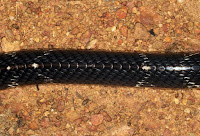Size: 25 cm- 140 cm
Colouration
Back bluish black to a pale faded bluish grey, with white cross bars occurring in pairs which become less distinct at the anterior end. These cross bars are prominent in juveniles or young animals and the lines gradually disappear or become reduced to scattered cross bars in adults. The ventral side, or the underside is off-white.
Simple identification character
Large hexagonal shaped scales running down its spine. Scales on its back are smooth, with the mid row much larger than all the other surrounding scales. This feature is the most important characteristic when identifying the species.
The cross bars gradually diminishing in adults.
But both show enlarged hexagonal scale rows along the spine.
It is a nocturnal species that is aggressive at night. Commonly found in and around human settlements. May attack if threatened but generally nonaggressive during day time. Will roll into a ball with its head well-concealed when agitated, and might spring out from this position upon further agitation. Feeds on: Other snakes, geckoes, lizards, rodents etc. Reproduction: They lay 10- 16 eggs per clutch.
Distribution: Non-endemic. Distributed in the dry, arid, and intermediate zones.
Feeds on: Other snakes, geckoes, lizards, rodents etc.
Reproduction: They lay 10- 16 eggs per clutch.
Distribution: Non-endemic. Distributed in the dry, arid, and intermediate zones.
Feeds on: Other snakes, geckoes, lizards, rodents etc.
Reproduction: They lay 10- 16 eggs per clutch.





No comments:
Post a Comment